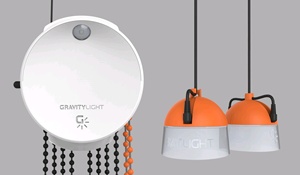Move over kerosene, solar lamps – GravityLight is here
By By Jagdeep Worah | 08 Jul 2017
Finding an alternative source of energy to generate light that does not use fossil fuels – particularly in poor, rural areas – has been exercising some of the world's brightest minds for some time now. Most households without electricity use kerosene, which is both expensive and has obvious ecological drawbacks. And while solar lamps have been around for some time, they suffer from the obvious drawback that their energy source – the sun – is not available after dark, when they are most needed.

Enter GravityLight - a gravity-powered lamp designed by the company Deciwatt for use in developing nations as a replacement for kerosene lamps. Combining kinetic and potential energy, it uses a bag filled with rocks or earth, attached to a cord, which slowly descends similar to the weight drive in a cuckoo clock. This action powers the light for up to thirty minutes, producing a light the makers claim is over five times brighter than a typical open-wick kerosene lamp.
Spearheading the movement is the GravityLight Foundation. According to its website, rather than undermining the local economy by giving away free products, they are working through local distribution partners and sales agents. This means that people can earn a living through selling GravityLights and similar products.
The project started in 2009, when an award-winning design consultancy was approached by SolarAid, a UK charity with a mission to eradicate kerosene lamps. The team at SolarAid wanted to develop an extremely low-cost solar light, in order to reach off-grid families living on less than $3 a day.
Designers Martin Riddiford and Jim Reeves took on the challenge. Realising that batteries comprised a third of the product's cost and PV panels, another third, they quickly realised the need to look beyond solar and battery powered devices.
Riddiford and Reeves started with a user's perspective and a blank sheet of paper. Creating something ''better than a kerosene lamp'' became the benchmark for the amount of light needed. This led Martin and Jim to explore what much lower levels of power could deliver. Months of concept development and early prototypes followed.
Riddiford and Reeves worked on GravityLight as a side project for four years. The first IndieGoGo campaign of GravityLight ended on 15 January 2013 with $399,590 funded by 6,219 funders.
The second IndieGoGo campaign, GravityLight 2: Made in Africa ended on 18 July 2015. It featured an improved design and the goal of manufacturing them in Kenya.
There are no operating costs after the initial purchase of the appliance. A standard GravityLight kit comes with an adjustable lamp and a ballast bag. The light can be turned on by filling the bag with approximately 10 kg of weight and lifting it up to the base of the device; the weight falls over a period of 25 minutes, pulling a cord/strap that spins gears and drives an electric generator, which continuously powers an LED bulb. This creates enough energy to last 25 minutes whenever it is needed.
The second model, GL02, also includes two SatLights and connecting cables. These are separate lights that are wired in series from the main GravityLight unit.
Each SatLight can be turned on or off separately. When used with SatLights, the light on the main unit can be turned on or off. Up to 4 SatLights can be connected, giving extra light to different locations in the house. The rate of the bag drop is almost not affected by the number of SatLights attached.
The original GravityLight used a strap for pulling up the weight. The improved GL02 used a plastic-bead chain on a pulley system. The pulley system requires less strength to pull up.
In trials, over 90 per cent of the off-grid households who tried the GravityLight prototype (GL01) said they would use it instead of a kerosene lamp. GravityLight was called one of The 25 Best Inventions of the Year 2013 by Time Magazine.







.webp)














